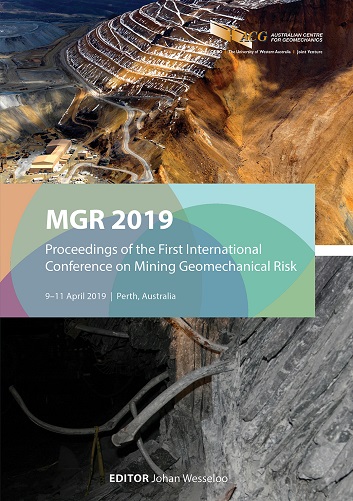Development of the Mine Geotechnical Risk Index

|
Authors: Narendranathan, S; Cheng, M |
DOI https://doi.org/10.36487/ACG_rep/1905_28_Narendranathan
Cite As:
Narendranathan, S & Cheng, M 2019, 'Development of the Mine Geotechnical Risk Index', in J Wesseloo (ed.), MGR 2019: Proceedings of the First International Conference on Mining Geomechanical Risk, Australian Centre for Geomechanics, Perth, pp. 461-474, https://doi.org/10.36487/ACG_rep/1905_28_Narendranathan
Abstract:
The authors have developed the Mine Geotechnical Risk Index (MGRI), which has been advanced to attribute tolerable thresholds of risk in a given transitional mine closure context. This paper presents the philosophy behind the development of the MGRI using a conceptual case study and sets out how the authors propose it could be applied by practitioners in particular scenarios only when assessing tolerable thresholds of risk. The reader should note that this approach is not intended to replace conventional engineering risk assessments, it is merely an alternative method in evaluating the ‘tolerability’ of elevated risk thresholds.
Keywords: Probability of Failure, Factor of Safety, geotechnical risk index, slope stability, circular failure, coal sliding, acceptable risk, brown coal, pit lake, mine rehabilitation
References:
Ágústsson, K, Jóhanneson, T, Sauermoser, S, Sigurðsson, Hó & Jensen, EH 2003, Hazard Zoning for Bíldudalur, Vesturbyggð,
Ammann, WJ 2005, ‘Natural hazards: risk concept and integral risk management’, in WJ Ammann, S Dannenmann & L Vulliet (eds), Proceedings of RISK21 – Coping with Risks due to Natural Hazards in the 21st Century, A.A. Balkema, Rotterdam.
Australian Geomechanics Society 2000, Landslide Risk Management Concepts and Guidelines, Australian Geomechanics Society, Perth.
Bell R, Glade, T & Danscheid M 2005, Risks in Defining Acceptable Risk Levels, University of Bonn, Bonn.
Borter, P 1999, ‘Risikoanalyse bei gravitativen naturgefahren: methode’, Umwelt-Materialien, no. 107/I.
Brown, T & Booth, A 2009, ‘Risk management’, in J Read & P Stacey, Guidelines for Open Pit Slope Design, CSIRO Publishing, Collingwood, pp. 382–400.
Call, RD 1992, ‘Slope stability’, in HL Hartman (ed.), SME Mining Engineering Handbook, vol. 1, pp. 881–896.
Chowdhury, RN 1992, ‘Probabilistic risk analysis in geomechanics and water engineering’, in RN Chowdhury (ed.), Geomechanics and Water Engineering in Environmental Management, A.A. Balkema, Rotterdam.
Geotechnical Engineering Office 1997, Landslides and Boulder Falls from Natural Terrain: Interim Risk Guidelines, GEO report no. 75. Geotechnical Engineering Office, Kowloon.
Glade, T, Anderson, MG & Crozier, MJ 2005, Landslide Hazard and Risk, John Wiley & Sons, Chichester.
Harr, ME 1977, The Mechanics of Particulate Media: A Probabilistic Approach, McGraw-Hill Book Company, New York, p. 543.
Harr, ME 1987, Reliability Based Design in Civil Engineering, McGraw-Hill Book Company, New York, p. 290.
Hoek, E & Bray, JW 1974, Rock Slope Engineering, 3rd edn, Institution of Mining and Metallurgy, London, pp. 150–224.
Hoek, E & Brown, ET 1997, ‘Practical estimates of rock mass strength’, International Journal of Rock Mechanics and Mining,
vol. 34, no. 8, pp. 1165–1186.
IUGS Working Group on Landslides – Committee on Risk Assessment 1997, ‘Quantitative assessment for slopes and landslides – the state of the art’, in DM Cruden & R Fell (eds), Proceedings of the Workshop on Landslide Risk Assessment, A.A. Balkema, Rotterdam, pp. 3–12.
Jóhannesson, T & Ágústsson, K 2002, Hazard Zoning for Debris Flows, Rockfall, Slushflows and Torrents and Slushflows Mixed with Soil in Steep Slopes, report TóJ/Kri-2002/01, Icelandic Meteorological Office, Reykjavík, in Icelandic
Jónasson, K, Sigurdsson, SP & Arnalds, P 1999, Estimation of Avalanche Risk, report VÍ-R99001-ÚR01, Icelandic Meteorological Office, Reykjavík.
Lee, EM & Jones, DKC 2004, Landslide Risk Assessment, Thomas Telford, London.
Lilly, PA 1982, A General Definition of Excavation Reliability and its Application in Mining Engineering, Western Australia School of Mines, Kalgoorlie.
Lilly, PA 2000, The Minimum Total Cost Approach to Optimise Pit Slope Design, Western Australia School of Mines, Kalgoorlie.
Malone, AW 2005, ‘The story of quantified risk and its place in slope safety policy in Hong Kong’, in T Glade, MG Anderson & M Crozier (eds), Landslide Hazard and Risk, John Wiley & Sons, Chichester.
Martin, DC & DR, Piteau 1978, ‘Select berm width to control local failure’, Engineering and Mining Journal, June 1978, pp. 161–164.
McMahon, BK 1985, ‘Geotechnical design in the face of uncertainty’, Australian Geomechanics News, no. 10.
Narendranathan, S 2009, ‘Fundamentals of probabilistic slope design and its use in pit optimization’, Proceedings of the 43rd US Rock Mechanics Symposium & 4th US - Canada Rock Mechanics Symposium, American Rock Mechanics Association, Alexandria.
The Ministry of the Environment 2000, Reglugerð nr. 505/2000, Reglugerð um Hættumat Vegna Ofanflóða, Flokkun og Nýtingu Hættusvæða og gerð Bráðabirgðahættumats (Regulation on hazard zoning for avalanches, debris flows and rockfall,
Xu, D & Chowdhury, RN 1999, ‘Probabilistic analysis of structured rock slopes – several methods compared’, Slope Stability Engineering, A.A. Balkema, Rotterdam. pp. 1089–1094.
Xu, D, Lilly, PA & Walker, PA 2000, ‘Stability and risk assessment of pit walls at BHP Iron Ore’s Mt Whaleback mine’, Proceedings of GeoEng2000: An International Conference on Geotechnical and Geological Engineering, Technomic Publishing Co., Lancaster.
© Copyright 2025, Australian Centre for Geomechanics (ACG), The University of Western Australia. All rights reserved.
View copyright/legal information
Please direct any queries or error reports to repository-acg@uwa.edu.au
View copyright/legal information
Please direct any queries or error reports to repository-acg@uwa.edu.au
